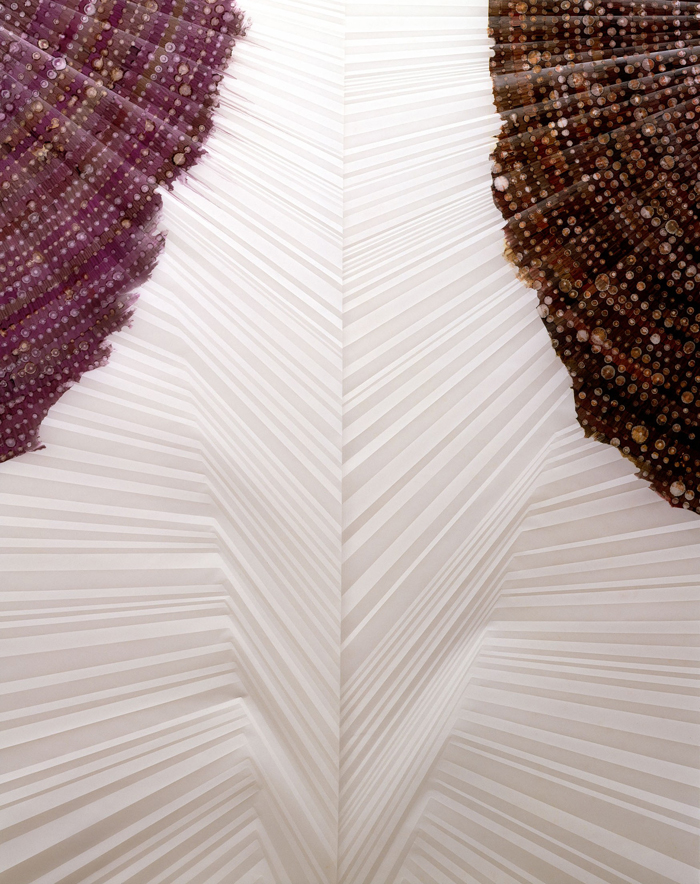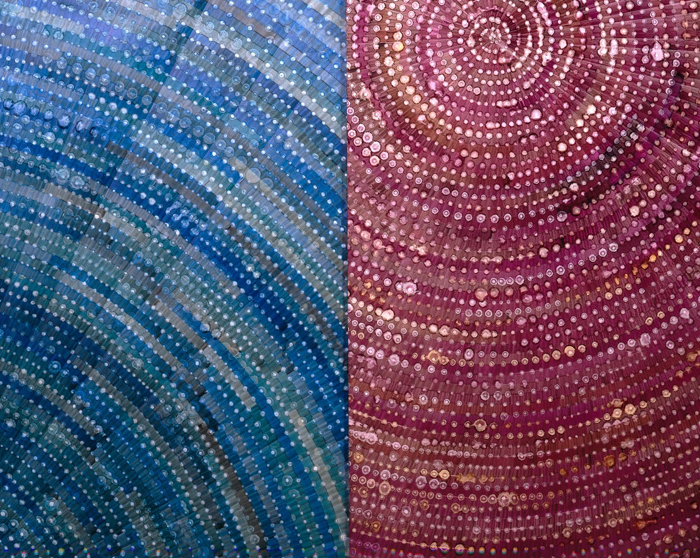Everything philosophy and science teaches us exponentially exposes all that we do not know — the light of knowledge illuminates the edges of the vast invisible. Sandeep Mukherjee’s work, shown at Sister Gallery in the heart of Chinatown, performs a similar operation. Spinning colors in a centrifugal trajectory, Mukherjee’s work moves endlessly outwards, aiming for the edges of infinity. Comprehending infinity, a goal that can be articulated but never directly obtained, is here made visible in a series of powerful pictorial gestures, sophisticated in their simplicity and relevant in their preoccupation with art historical concerns.
When entering the tall space of the gallery, the entire room seems to pulse with the work’s rhythmic breath. Hung only on one side of the gallery, five consecutive panels of radiant ochre, olive-green, brandy, lavender, and petroleum blue spirals reside in a chiseled topography of embossed Duralene (a frosted, translucent material that resembles vellum). Dimension is rendered both optically and physically. This complex juxtaposition activates a viewer’s vision as well as engendering a more physical sensation of the work in the gallery space.
From an off-center core, acrylic ink marks escalate in a revolving thrust. Mukherjee gives a sense of depth to each of the separate spiral formations by alternating tints throughout a progression of tiers. Mimicking successive beats, the pictorial space moves — not only does it recede into the perspective of a painting as window, but also advances into the space occupied by the viewer. An image of palpitation echoes the behavior of matter moving in waves — a rhythmic progression that theoretically can continue forever. The enormous spirals seem to carry on far and wide, not only beyond their manifestation on the painting’s ground but in all possible dimensions.
In a gesture of removal, Mukherjee eliminates parts of the spirals, dissolving the acrylic ink with alcohol after the fact, thus exposing bare areas of the pallid ground surface. The pictorial space created in ink is heightened by a pattern of rays, physically embossed into the Duralene that emanate from the core of the spiral and continue into the cleared space. The folds become more visible in the frosted areas, like rays of sunlight in a delicate cloud of smoke or dust. Beyond the physical dimensionality of the creased paper, in its cast shadows and captured light, the pattern of vectors creates an optical spatial dimension. Fanning from the centers of the color spirals, the geometrical grooves add an additional sense of rotation.

In joining two orders of spatial rendition, Mukherjee creates work that swings the viewer between multiple visual and sensational experiences. The two kinds of viewing the work demands pose a pictorial paradox, a philosophical proposition made visible.
The heart of the art historical debates about the relations of viewer and work echoes a philosophical turn to thinking about being in relation to time. From the time of Nabis painter Maurice Denis all the way to the eras of critic Clement Greenberg and historian Michael Fried, there have been theories that suggest the viewer of non-narrative abstract art should absorb all aspects of the artwork simultaneously. This simultaneity is the condition that enables the viewer to transcend her or his physical body. In contrast, the epistemological break proposed by minimalism required an active viewer who experiences aspects of an artwork in succession, over time. Anathematizing the conceits of modernist abstraction, minimalists emphasized the temporal (and therefore narrative) properties of the art experience. This line of reasoning spawned, as Rosalind Krauss has identified it, the “embodied” viewer of art in the 1980s.

And it is the embodied viewer of the 1980s who remains today to experience an artwork that speaks to its own history, undermining foundational theories by blurring their axiomatic distinctions. Mukherjee’s artwork functions both in space and in time, posing an alternative to the powerful arguments set forth by Greenberg and Fried of art that critiques itself by emphasizing the formal properties unique to itself.
Intervening into the history of pictorial vocabulary, Mukherjee takes further the minimalist proposition of the embodied viewer. The paradoxical existence of, on the one hand, simultaneous viewing and, on the other, time-based viewing, is activated in the pictorial as well as the physical elements of his artwork. The spirals, abstract in their initial appearance, compel the viewer to come close to the painting, and “read” their syntax by following a narrative of marks interspersed by luminous dots of exposed Duralene that function like commas. By blinking and thus reorienting the perceptual apparatus of focus and depth of field, the viewer can then flip into the alternative matrix and again sense the entirety of the spiral throbbing back and forth. These two modes of viewing require not only two different positions in space or two varying way of looking, but ultimately two ways of being in the world. In concert, the creased spokes also function in at least two contradictory ways. Rotating from the core like a Duchampian bicycle wheel, they create an illusion of movement, only to take abrupt turns into a more perspectival sense of space. Riding up and down the topography of grooves, the viewer may switch back and forth between an illusion of space and the physical material.
With shudders of color and line, the light in the room seems to vibrate as the work begins to seem like enormous irises. Here, far, and very close, what we encounter on the edges of the visible is a painting looking at the viewer.
Nizan Shaked is an independent curator and a Visiting Assistant Professor of Art History at the University of La Verne.
